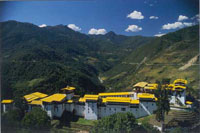TRONGSA (alt. 2,300m)
Trongsa forms the central hub of the nation and is historically the place from where attempts at  unifying the country were launched. Both His Majesty King Ugyen Wangchuck, the Penlop of Trongsa, who was elected the country’s first hereditary monarch and his successor, King Jigme Wangchuck, ruled the country from Trongsa ancient seat. The Crown Prince of Bhutan normally holds the position of the Trongsa Penlop prior to ascending the throne including the present King who was appointed Penlop in 1972, shortly before his succession to the throne. The entire landscape around Trongsa is spectacular. unifying the country were launched. Both His Majesty King Ugyen Wangchuck, the Penlop of Trongsa, who was elected the country’s first hereditary monarch and his successor, King Jigme Wangchuck, ruled the country from Trongsa ancient seat. The Crown Prince of Bhutan normally holds the position of the Trongsa Penlop prior to ascending the throne including the present King who was appointed Penlop in 1972, shortly before his succession to the throne. The entire landscape around Trongsa is spectacular.
Places of Interest in TRONGSA
Chendbji Chorten
Approximate four hours drive from Wangduephodrang is Chendbji Chorten, patterned on Swayambhunath temple in Kathmandu. It was built in 18th century by Lama Shida, from Tibet, to cover the remains of an evil spirit that was subdued at this spot.
Trongsa Dzong
Like almost all towns in the Kingdom, this Dzong architecture dominates the entire Trongsa horizon dwarfing the surrounding buildings. Built in 1648, it was the seat of power over central and eastern Bhutan. Both the first and second King ruled the country from this ancient seat. Protected from invaders by an impenetrable valley, Trongsa Dzong is an impregnable fortress. The Dzong itself is a labyrinth of temples, corridors and offices holding court over the local community. It is built on many levels into the side of the hill and can be seen from every approach to Trongsa heralding its strength as a defensive stronghold.
Ta Dzong
This watch tower which once guarded Trongsa Dzong from internal rebellion, stands impressively and provides visitors an insight into historical significance of Trongsa in Bhutan’s history.
Excursions around TRONGSA
Kuenga Rabten
It is about 23 km, one hour interesting drive from Trongsa. Kuenga Rabten was the winter palace of the second King and now looked after by National Commission for Cultural Affairs. It is pleasant afternoon trip from Trongsa and offers good insight into the early days of Bhutan monarchy.
|
